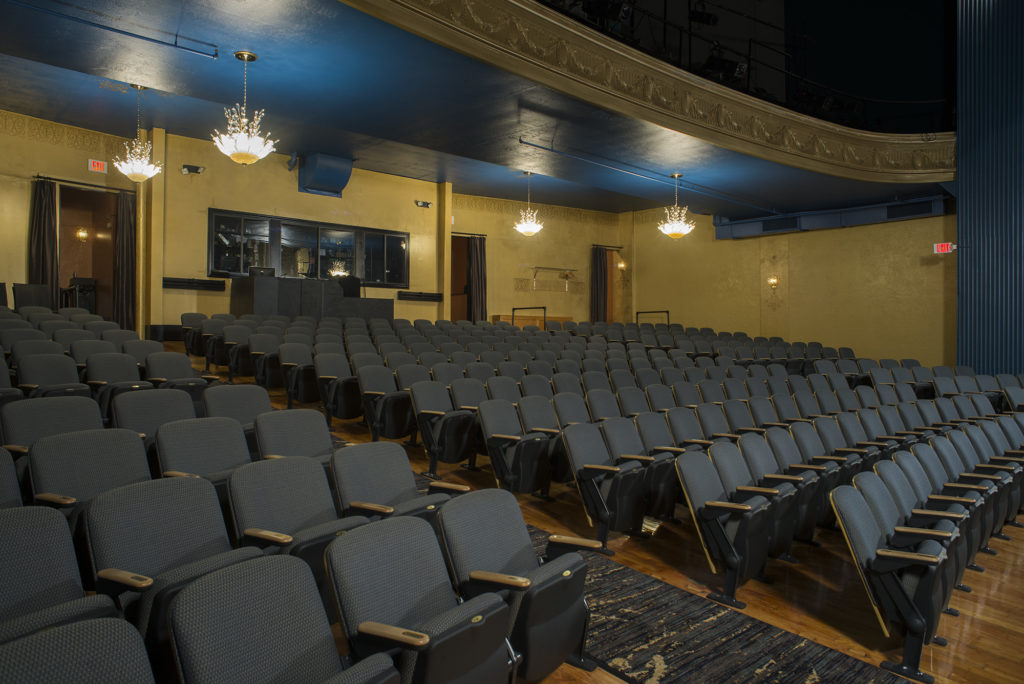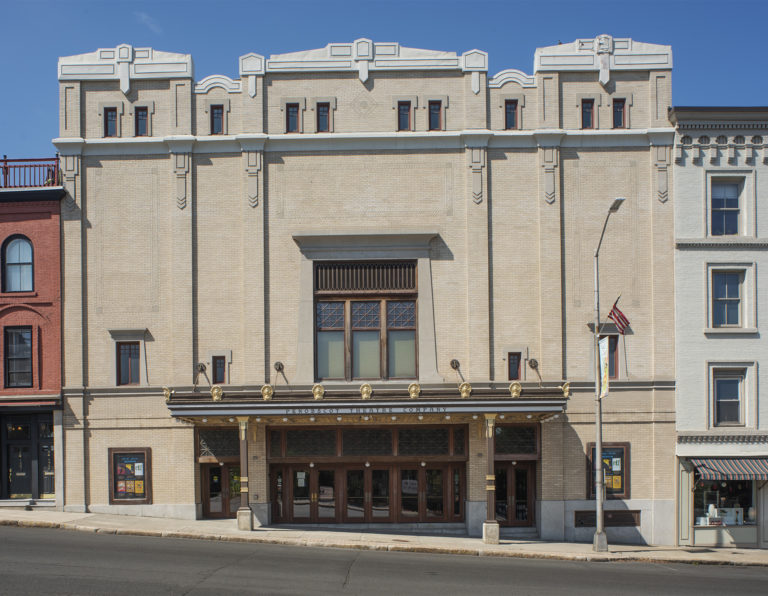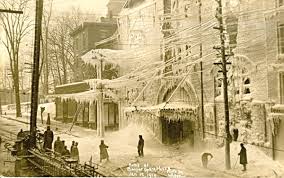Our History
A Brief History of Penobscot Theatre Company
Penobscot Theatre Company has a rich 50-year history with roots in the Acadia Repertory Theatre, founded in Bangor in 1973 by George Vafiadis and Lou Collier. Acadia Rep presented 97 productions in Bangor before Penobscot Theatre Company was incorporated as a 501(c)3 in 1983. The School For Wives was the first play officially produced by the nonprofit. Acadia Rep still operates on Mount Desert Island as a separate entity, while Penobscot Theatre Company is the only year-round, professional regional theatre in Northern Maine.
George Vafiadis oversaw the theatre’s early development, serving as Producing Director from 1983 through 1990. Joining him was Kenneth Stack, Artistic Director from 1983 to 1989. Bangor’s historic Parish House at 183 Main Street was the first site of the theatre’s performances and operations. In 1986, the organization raised $160,000 for the purchase and initial renovation of the property. Penobscot Theatre Company sold the Parish House to Merrill Bank in 2004.
Joe Turner Cantu became Artistic Director in 1990 and remained in that position through 1992, when the Board of Directors named Mark Torres Producing Artistic Director. Torres led the theatre for the next 13 seasons. During his tenure, the theatre reorganized to operate with paid professionals, tripled the budget, and increased attendance to more than 15,000 annually. Torres also broadened the theatre’s activity to include the annual Maine Shakespeare Festival, which performed on the banks of the Penobscot River for seven summers.
In 1997, the company acquired the Bangor Opera House, which now serves as its base of operations. In 2005, the Board hired Scott R.C. Levy as Producing Artistic Director. Under Levy’s leadership from 2005-2011, Penobscot Theatre Company toured productions throughout the state of Maine, created the Northern Writes New Play Festival, and restored the façade of the Bangor Opera House.
Upon Levy’s departure, the Board instituted a dual leadership structure, and hired Marcie Bramucci as Managing Director and Bari Newport as Artistic Director. Mary Budd was also appointed as PTC’s first Executive Director.
During her nine years at the company, Newport headed artistic, facility, audience and financial growth. The budget more than doubled, from $850,000 to $1.8 million. Audience size grew from 30,000 to 40,000 (with some theatergoers coming from Canada) and added a seventh show to the season. The inside of the 350-seat Opera House was refurbished, and both the Scene Shop and Actor Housing were acquired. In 2012, Newport launched an endowment fund, which became fully funded with a $1million donation in 2020 – ensuring the survival of the company in the face of the pandemic.
In late 2020 the Opera House closed its doors due to the COVID-19 pandemic. The end of the 46th season was cancelled and the company set to work creating and producing a fully digital 47th season called Digitus Theatrum. This season featured unique and one-of-a-kind collaborations with different artists in Maine and beyond. While content was digital, the theatre was able to successfully keep all employees on payroll doing various projects. The production team worked to renovate the bathrooms and dressing rooms at the Opera House, and at the Theatre Factory, costume storage was renovated and an online inventory system for all furniture, props, and costumes was established.
In 2021 Newport left the company and longtime Production Manager, Tricia A. Hobbs, stepped in as Acting Artistic Director. At the end of 2021 the Board of Directors launched a national search which concluded in 2022 with the hiring of Jonathan Berry. Berry stepped in as PTC’s new Artistic Director alongside Executive Director, Jen Shepard. Penobscot Theatre Company is thrilled to have become a cultural force for the arts in the greater Bangor area and is currently preparing to celebrate its 49th season of providing engaging and thought-provoking theater to the heart of Maine and beyond.
 A Brief History of the Bangor Opera House
A Brief History of the Bangor Opera House
In 2011, architectural historian Deborah Thompson, PhD, captured the rich history of our home as follows:
In January 1914, Bangor’s handsome Richardsonian Romanesque Opera House, (1882, Arthur H. Vinal, architect), burned and had to be demolished. The lot was purchased by Joseph P. Bass in February 1919, (Bass was a prominent businessman and publisher of the Bangor Daily Commercial), who announced that the Opera House would be rebuilt for the lessee, the Alfred S. Black chain of theatres. Edward J. Bolen of Old Orchard Beach and Boston was named the architect at the same time. Renderings of the façade and descriptions (quoted below) appeared in the press.
 This beige “terracotta brick” façade with “white cast stone trimming, marble effect” was an imaginative Art Deco Egyptianizing design with Art Nouveau overtones. The interior contained an impressive organ and was decorated in what the newspapers called the “Adam” style:
This beige “terracotta brick” façade with “white cast stone trimming, marble effect” was an imaginative Art Deco Egyptianizing design with Art Nouveau overtones. The interior contained an impressive organ and was decorated in what the newspapers called the “Adam” style:
“This is of graceful and beautiful effect, the wreaths, ovals and festoons of the design being attractive without being too ornate. The colorings will be grey, blue, ivory and old gold in the lighter shades.”
The second Opera House was the last in a long line of downtown Bangor theatres which began in 1836. In 1966 it became Bangor Cinema, and a number of unfortunate changes including that of the marquee occurred over the years. For a while it was used for concerts of the Bangor Symphony Orchestra. However, deferred maintenance took a toll on the exterior and interior of the building.
The building was acquired by the Penobscot Theatre Company in 1997. The company had been operating in the Unitarian Memorial Vestry, (Wilfred E. Mansur, architect, 1888), which they first leased and then purchased in 1986, with the help of the greater Bangor community. The theatre sold the vestry to Merrill Bank (now People’s United Bangor Bank) in 2004, and the Vestry then underwent a major restoration as a banking center. The Penobscot Theatre has been engaged in the restoration of the Opera House since acquiring it. The façade was beautifully restored in the winter of 2007-08 while the theatre remained in operation (G. Drake Masonry), and a replica of the original marquee was later put in place. (The Opera House is included in the Main Street Historic District under the ordinances of the City of Bangor.) The project received the 2009 Honor Award for Community Revitalization from Maine Preservation.
 In 2016, the company launched a capital campaign to support a number of building improvements, and our patrons and the philanthropic community responded generously. With leading support from the Grants to Green program, the company upgraded its HVAC to a high-efficiency system powered by natural gas, invested in state-of-the-art LED theatrical lighting, which enriched productions while lowering energy costs; and made numerous repairs to tighten the building envelope, realizing a 20 percent decrease in draftiness from the prior year. For the start of its 44th Season, the company also replaced the 322 chairs occupying the orchestra level, refinished the original wood flooring, replaced threadbare carpet, and installed elegant lighting fixtures to illuminate fresh wall colors and decorative accents.
In 2016, the company launched a capital campaign to support a number of building improvements, and our patrons and the philanthropic community responded generously. With leading support from the Grants to Green program, the company upgraded its HVAC to a high-efficiency system powered by natural gas, invested in state-of-the-art LED theatrical lighting, which enriched productions while lowering energy costs; and made numerous repairs to tighten the building envelope, realizing a 20 percent decrease in draftiness from the prior year. For the start of its 44th Season, the company also replaced the 322 chairs occupying the orchestra level, refinished the original wood flooring, replaced threadbare carpet, and installed elegant lighting fixtures to illuminate fresh wall colors and decorative accents.
2020 marked the 100th Anniversary of the Bangor Opera House. We celebrated the occasion with a Jubilee Gala that took place at the Bangor Opera House on February 29th, 2020. At that event we launched the Centennial Patron Campaign in which we challenged ourselves to find 100 patrons to give $1,000 or more. An audacious campaign which was significantly interrupted by the worldwide shutdown. We thought for a time that we wouldn’t make it but we did as of June 2021! We’re grateful to all of our patrons for their generosity towards this company and our 100-year-old home, The Bangor Opera House. These funds will help sustain the entire organization to spark the next century of imagination.
In commemoration of this campaign and the anniversary, a pair of bronze plaques will be placed outside the entrance to the theatre. The plaques commemorate the historic nature of our home and the 104 patrons who believe that we inspire a love of the theater arts in the heart of Maine and beyond.
On October 1st, 2021, we gathered to celebrate the dedication of the Centennial Patron Plaques. We toasted the patrons who donated with an eye towards the future care of our home, The Bangor Opera House.
